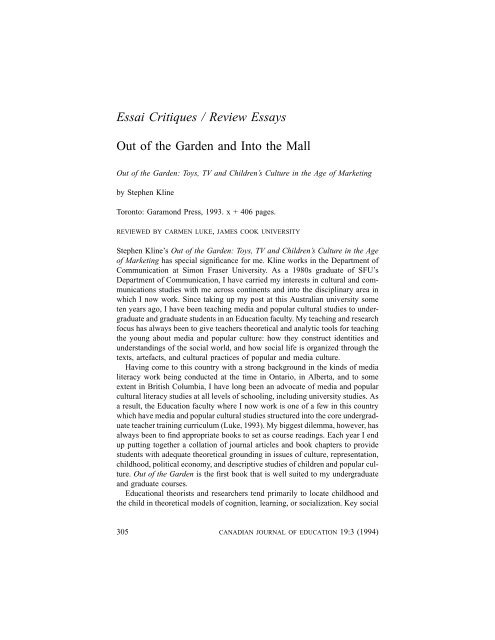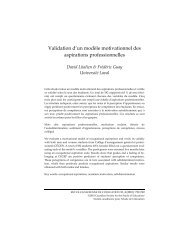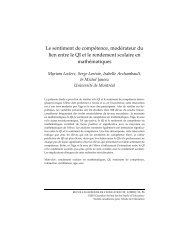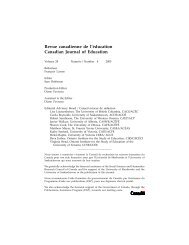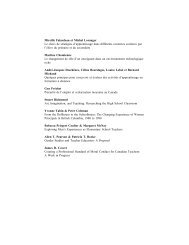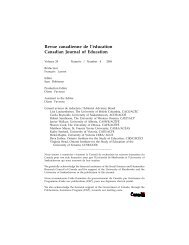Essai Critiques / Review Essays Out of the Garden and Into the Mall
Essai Critiques / Review Essays Out of the Garden and Into the Mall
Essai Critiques / Review Essays Out of the Garden and Into the Mall
You also want an ePaper? Increase the reach of your titles
YUMPU automatically turns print PDFs into web optimized ePapers that Google loves.
<strong>Essai</strong> <strong>Critiques</strong> / <strong>Review</strong> <strong>Essays</strong><br />
<strong>Out</strong> <strong>of</strong> <strong>the</strong> <strong>Garden</strong> <strong>and</strong> <strong>Into</strong> <strong>the</strong> <strong>Mall</strong><br />
<strong>Out</strong> <strong>of</strong> <strong>the</strong> <strong>Garden</strong>: Toys, TV <strong>and</strong> Children’s Culture in <strong>the</strong> Age <strong>of</strong> Marketing<br />
by Stephen Kline<br />
Toronto: Garamond Press, 1993. x + 406 pages.<br />
REVIEWED BY CARMEN LUKE, JAMES COOK UNIVERSITY<br />
Stephen Kline’s <strong>Out</strong> <strong>of</strong> <strong>the</strong> <strong>Garden</strong>: Toys, TV <strong>and</strong> Children’s Culture in <strong>the</strong> Age<br />
<strong>of</strong> Marketing has special significance for me. Kline works in <strong>the</strong> Department <strong>of</strong><br />
Communication at Simon Fraser University. As a 1980s graduate <strong>of</strong> SFU’s<br />
Department <strong>of</strong> Communication, I have carried my interests in cultural <strong>and</strong> communications<br />
studies with me across continents <strong>and</strong> into <strong>the</strong> disciplinary area in<br />
which I now work. Since taking up my post at this Australian university some<br />
ten years ago, I have been teaching media <strong>and</strong> popular cultural studies to undergraduate<br />
<strong>and</strong> graduate students in an Education faculty. My teaching <strong>and</strong> research<br />
focus has always been to give teachers <strong>the</strong>oretical <strong>and</strong> analytic tools for teaching<br />
<strong>the</strong> young about media <strong>and</strong> popular culture: how <strong>the</strong>y construct identities <strong>and</strong><br />
underst<strong>and</strong>ings <strong>of</strong> <strong>the</strong> social world, <strong>and</strong> how social life is organized through <strong>the</strong><br />
texts, artefacts, <strong>and</strong> cultural practices <strong>of</strong> popular <strong>and</strong> media culture.<br />
Having come to this country with a strong background in <strong>the</strong> kinds <strong>of</strong> media<br />
literacy work being conducted at <strong>the</strong> time in Ontario, in Alberta, <strong>and</strong> to some<br />
extent in British Columbia, I have long been an advocate <strong>of</strong> media <strong>and</strong> popular<br />
cultural literacy studies at all levels <strong>of</strong> schooling, including university studies. As<br />
a result, <strong>the</strong> Education faculty where I now work is one <strong>of</strong> a few in this country<br />
which have media <strong>and</strong> popular cultural studies structured into <strong>the</strong> core undergraduate<br />
teacher training curriculum (Luke, 1993). My biggest dilemma, however, has<br />
always been to find appropriate books to set as course readings. Each year I end<br />
up putting toge<strong>the</strong>r a collation <strong>of</strong> journal articles <strong>and</strong> book chapters to provide<br />
students with adequate <strong>the</strong>oretical grounding in issues <strong>of</strong> culture, representation,<br />
childhood, political economy, <strong>and</strong> descriptive studies <strong>of</strong> children <strong>and</strong> popular culture.<br />
<strong>Out</strong> <strong>of</strong> <strong>the</strong> <strong>Garden</strong> is <strong>the</strong> first book that is well suited to my undergraduate<br />
<strong>and</strong> graduate courses.<br />
Educational <strong>the</strong>orists <strong>and</strong> researchers tend primarily to locate childhood <strong>and</strong><br />
<strong>the</strong> child in <strong>the</strong>oretical models <strong>of</strong> cognition, learning, or socialization. Key social<br />
305 CANADIAN JOURNAL OF EDUCATION 19:3 (1994)
306 ESSAIS CRITIQUES / REVIEW ESSAYS<br />
<strong>and</strong> textual sites for childhood socialization are commonly seen as <strong>the</strong> family,<br />
school, children’s literature, <strong>and</strong> school texts. Few academic educators <strong>the</strong>orize<br />
childhood in terms <strong>of</strong> how it is structured <strong>and</strong> experienced in <strong>the</strong> marketplace <strong>of</strong><br />
contemporary culture. In North America, <strong>the</strong> few critical educational <strong>the</strong>orists<br />
who do acknowledge <strong>and</strong> attempt to incorporate a “cultural studies” into curriculum<br />
<strong>and</strong> pedagogy, however, have pretty much operated at <strong>the</strong> level <strong>of</strong> generalized<br />
calls to incorporate a cultural politics into classroom discourse. Among<br />
educators, children’s popular culture is commonly dismissed as a negative influence<br />
on literacy, cognitive, moral, <strong>and</strong> social development (cf. Postman, 1982).<br />
The cultural culprit: capitalist mass commodification <strong>of</strong> childhood experience<br />
through <strong>the</strong> media texts, iconography, toys, video games, <strong>and</strong> spin-<strong>of</strong>f merch<strong>and</strong>ise<br />
that make those experiences concrete through ownership, <strong>and</strong> <strong>the</strong> linguistic<br />
<strong>and</strong> behavioural/play repertoires <strong>the</strong>y enable. In much contemporary work, <strong>the</strong>n,<br />
not a great deal is available that would lead us to critical <strong>the</strong>orization <strong>of</strong> childhood<br />
in relation to contemporary Western popular culture.<br />
The introduction to <strong>Out</strong> <strong>of</strong> <strong>the</strong> <strong>Garden</strong> maps <strong>the</strong> general argument <strong>and</strong> aims<br />
<strong>of</strong> this book. Kline surveys work on childhood in psychological, psychoanalytic,<br />
anthropological, educational, <strong>and</strong> sociological <strong>the</strong>ory in order to show how those<br />
discourses have <strong>the</strong>orized <strong>the</strong> child. In <strong>the</strong> models <strong>of</strong> <strong>the</strong>se disciplines, <strong>the</strong> child<br />
is conceptualized primarily as an object <strong>of</strong> family <strong>and</strong> school control <strong>and</strong> socialization,<br />
all <strong>of</strong> which neglect to consider <strong>the</strong> historically variable influences <strong>of</strong><br />
cultural commodities (including, for instance, books) on children’s personality<br />
<strong>and</strong> social development. Kline <strong>the</strong>n locates his <strong>the</strong>oretical point <strong>of</strong> departure,<br />
which has its roots in <strong>the</strong> works <strong>of</strong> Canadian communication <strong>the</strong>orists Harold<br />
Innis <strong>and</strong> Marshall McLuhan, <strong>and</strong> in neo-Marxian analyses <strong>of</strong> culture industries.<br />
This latter <strong>the</strong>oretical framework guides <strong>the</strong> few o<strong>the</strong>r recent works available on<br />
media <strong>and</strong> children, most notably Susan Willis’ (1991) A Primer for Daily Life,<br />
<strong>and</strong> Marsha Kinder’s (1991) Playing with Power in Movies, Television <strong>and</strong> Video<br />
Games: From Muppet Babies to Teenage Mutant Ninja Turtles.<br />
Chapter 1 takes up <strong>the</strong> concept <strong>and</strong> practices <strong>of</strong> marketing strategies. Marketing<br />
strategies, following Raymond Williams, are never simple <strong>and</strong> straightforward,<br />
or conspiratorial. Ra<strong>the</strong>r, like audience uptake, <strong>the</strong>y are highly differentiated<br />
<strong>and</strong> open to renegotiation <strong>and</strong> change within broad-based “regularities” <strong>and</strong><br />
“similarities” <strong>of</strong> cultural expression. Although persons from different sociocultural<br />
locations <strong>and</strong> reading positions may well construct different meanings<br />
from <strong>the</strong> same text, such as a Coke commercial, <strong>the</strong>re is none<strong>the</strong>less a regularity<br />
<strong>of</strong> meaning associated with <strong>the</strong> genre <strong>of</strong> <strong>the</strong> s<strong>of</strong>t-drink ad, or <strong>the</strong> larger universal<br />
symbolic meanings associated with <strong>the</strong> Coke icon <strong>and</strong> <strong>the</strong> lifestyle <strong>and</strong> cultural<br />
connections it signifies. Marketing strategies, Kline explains, are similar: <strong>the</strong>y<br />
organize symbolic sign systems <strong>and</strong> information (a) to promote a product or<br />
service to <strong>the</strong> widest possible audience, <strong>and</strong> (b) to sell a “unified” audience<br />
segment to <strong>the</strong> market.
ESSAIS CRITIQUES / REVIEW ESSAYS 307<br />
Advertising is not just about selling products <strong>and</strong> audiences. Indeed, marketing<br />
communication has taken on a life <strong>of</strong> its own, comm<strong>and</strong>ing huge human <strong>and</strong><br />
financial resources, <strong>and</strong> riding <strong>the</strong> cutting edge <strong>of</strong> technological <strong>and</strong> computer<br />
innovation. Importantly, marketing is <strong>the</strong> conduit — <strong>the</strong> cultural glue — between<br />
representations <strong>of</strong> products (<strong>and</strong> associated lifestyle benefits) <strong>and</strong> <strong>the</strong> cultural<br />
practices <strong>of</strong> shopping, mall lounging, consumption, <strong>and</strong> reinvention <strong>of</strong> <strong>the</strong> self<br />
through product acquisition. In short, advertising links cultural ideas <strong>and</strong> symbols<br />
to <strong>the</strong> cultural referents <strong>and</strong> social practices within which we experience self <strong>and</strong><br />
o<strong>the</strong>r(s). Much as goods are more than material objects, so marketing strategies<br />
<strong>of</strong>fer more than <strong>the</strong> product: <strong>the</strong>y provide us with a narrative <strong>of</strong> culture <strong>and</strong><br />
social relations within which we can read ourselves <strong>and</strong> which give symbolic <strong>and</strong><br />
material substance to everyday experience. When we buy that cosmetic product,<br />
car, or computer game, we buy into both a cultural narrative as well as set <strong>of</strong><br />
real <strong>and</strong> material relations with <strong>the</strong> product (we drive it, wear it, or play with it),<br />
<strong>and</strong> <strong>the</strong> person(s) with whom we share social relations around that product.<br />
Drawing from works by childhood <strong>and</strong> cultural historians, Chapter 2 is an<br />
ambitious <strong>and</strong> syn<strong>the</strong>tic survey <strong>of</strong> <strong>the</strong> western history <strong>of</strong> children’s culture beginning<br />
in <strong>the</strong> Renaissance. A shift in adult affect toward children characterized new<br />
interests in childhood throughout <strong>the</strong> 18th <strong>and</strong> 19th centuries, which was reflected<br />
in increased output <strong>of</strong> children’s literature, toys, <strong>and</strong> clothing. Industrialization<br />
at <strong>the</strong> end <strong>of</strong> <strong>the</strong> 19th century saw <strong>the</strong> expansion <strong>of</strong> manufactured goods specifically<br />
for children. Educational reform movements, beginning with <strong>the</strong> Protestant<br />
Reformation <strong>and</strong> Catholic Counter-Reformation, contributed significantly to<br />
notions <strong>of</strong> childhood. This educational dimension <strong>of</strong> historical concepts <strong>of</strong><br />
childhood is closely linked to <strong>the</strong> advent <strong>of</strong> <strong>the</strong> printing press in <strong>the</strong> late 15th<br />
century, which generated various mass literacy campaigns throughout Europe.<br />
The perceived need for mass literacy, initially to ensure individual readership <strong>of</strong><br />
“The Word,” generated a parallel need for systematic schooling for print literacy.<br />
Print technology revolutionized learning, <strong>and</strong> <strong>the</strong> coding <strong>and</strong> dissemination <strong>of</strong><br />
knowledge. From a Foucauldian perspective, <strong>the</strong> printing press, literacy, <strong>and</strong><br />
schooling constructed an historically new social subject — <strong>the</strong> educable secular<br />
child. This new focus on childhood brought about a distinctive childhood culture<br />
through <strong>the</strong> advent <strong>of</strong> books for children, household <strong>and</strong> parenting guides, school<br />
textbooks, <strong>and</strong> a whole bureaucratic discourse centred on <strong>the</strong> institutionalization<br />
<strong>of</strong> children, learning, <strong>and</strong> knowledge in schools (Luke, 1989). This historical<br />
str<strong>and</strong> is taken up in somewhat more detail in Chapter 3.<br />
The advent in this century <strong>of</strong> radio <strong>and</strong> TV again brought about a revolution<br />
in ideas about <strong>and</strong> <strong>the</strong> social organization <strong>of</strong> <strong>the</strong> family <strong>and</strong> childhood. Radio <strong>and</strong><br />
TV relocated <strong>the</strong> family around a new technological hearth providing both information<br />
(consumer advertising, news, etc.), cultural stories, <strong>and</strong> entertainment.<br />
Advertising for a remodelled domesticity <strong>and</strong> post-war visions <strong>of</strong> progressive<br />
parenting produced new consumer products, cultural narratives, <strong>and</strong> social identities<br />
for a new generation <strong>of</strong> children <strong>and</strong> adults. Cultural discourses cashed in on
308 ESSAIS CRITIQUES / REVIEW ESSAYS<br />
economic progress, technological innovations, <strong>and</strong> <strong>the</strong> sensibilities <strong>of</strong> a new<br />
educated middle class charged with nurturing <strong>the</strong> next generation into <strong>the</strong> atomic<br />
age. The first wave <strong>of</strong> baby-boom children was born into an economically stable<br />
<strong>and</strong> leisure-oriented society in which progressive “good parenting,” much like<br />
good housekeeping, was seen as <strong>the</strong> cornerstone <strong>of</strong> a valiant new social order:<br />
educated, affluent, industrious, <strong>and</strong> industrialized. Reflecting this new social<br />
formation, <strong>the</strong> 1950s <strong>and</strong> 1960s family sit-coms modelled <strong>the</strong> discourses <strong>and</strong><br />
desires <strong>of</strong> suburban, white, <strong>and</strong> nuclear family life.<br />
Of related interest are Lyn Spigel’s (1992) Make Room for TV <strong>and</strong> Spigel <strong>and</strong><br />
deMann’s (1992) Private Screenings, which extend <strong>the</strong> debate about TV as<br />
domestic appliance, ideological node, <strong>and</strong> family cohesion device in <strong>the</strong> new<br />
post-war domesticity. Programs narrated <strong>the</strong> cultural stories <strong>and</strong> advertising<br />
promised to fill <strong>the</strong> wants <strong>and</strong> desires generated by those narratives. These<br />
included marketing <strong>the</strong> cultural goods <strong>and</strong> symbols which would ensure that<br />
children’s learning <strong>and</strong> development — enabled by <strong>the</strong> appropriate children’s toys<br />
<strong>and</strong> teen gadgetry — began early in life <strong>and</strong> continued after school hours. Marketing<br />
to children through <strong>the</strong> parental purse was meant to ensure that children<br />
displayed <strong>the</strong> same material affluence <strong>the</strong> parental house or car signified, <strong>and</strong> that<br />
<strong>the</strong> merch<strong>and</strong>ise <strong>of</strong> childhood — strewn on <strong>the</strong> front lawn, embodied in clothing,<br />
or consumed in <strong>the</strong> family kitchen — would reflect <strong>the</strong> material <strong>and</strong> emotional<br />
investments in childhood which Dr. Spock had preached to millions as <strong>the</strong> hallmark<br />
<strong>of</strong> progressive parenting. Growing up during <strong>the</strong> 1950s <strong>and</strong> 1960s in<br />
Canada in an immigrant household, I remember well what I would now call my<br />
experience <strong>of</strong> “cultural dissonance.” I watched my assimilated aspirations on <strong>the</strong><br />
small screen <strong>and</strong> was envious <strong>of</strong> <strong>the</strong> stuff o<strong>the</strong>r kids had because I was outside<br />
<strong>the</strong> cultural mainstream in a household where mixmasters, <strong>the</strong> latest toys,<br />
electronic toasters, colour TVs, or sweater sets with pearl buttons à la Fa<strong>the</strong>r<br />
Knows Best <strong>and</strong> Donna Reid were <strong>of</strong>f-limits. To <strong>the</strong>se products <strong>and</strong> to that culture,<br />
migrants <strong>and</strong> indigenous peoples are both outsiders <strong>and</strong> vicarious insiders.<br />
Even where consumption per se is beyond <strong>the</strong>ir reach, <strong>the</strong>y come to participate<br />
in <strong>the</strong> gendered networks <strong>of</strong> desire <strong>of</strong> product <strong>and</strong> program (Luke, in press).<br />
Chapter 4 maps <strong>the</strong> social <strong>and</strong> economic history <strong>of</strong> “<strong>the</strong> book” <strong>and</strong> print literacy<br />
in relation to literacy’s moral <strong>and</strong> socializing function for children. The<br />
construction <strong>of</strong> <strong>the</strong> literate child historically has been shaped by social, moral,<br />
<strong>and</strong> cultural imperatives institutionalized in <strong>the</strong> discourses <strong>of</strong> schooling since <strong>the</strong><br />
advent <strong>of</strong> <strong>the</strong> printing press <strong>and</strong> <strong>the</strong> transportable book. Whe<strong>the</strong>r 17th-century<br />
religious or secular school books, 18th-century travelogues, nursery-verse or story<br />
books, or 1940s <strong>and</strong> 1950s comic books — <strong>the</strong> aim <strong>of</strong> children’s books <strong>and</strong> children’s<br />
literacy has always been to tame <strong>the</strong> uncivilized, pre-literate unruly child<br />
through pedagogical <strong>and</strong> moral didacticism. Kline describes how English publisher<br />
John Newberry opened <strong>the</strong> way in <strong>the</strong> mid-18th century for lighter children’s<br />
literature <strong>and</strong> poetry which retained a strong instructional character but gave
ESSAIS CRITIQUES / REVIEW ESSAYS 309<br />
children <strong>the</strong>ir own genre <strong>of</strong> light-hearted fantasy <strong>and</strong> humour. Throughout <strong>the</strong><br />
1800s, Stevenson, Greenaway, Kingsley, Milne, <strong>and</strong> <strong>the</strong> Grimm <strong>and</strong> Anderson<br />
bro<strong>the</strong>rs generated a subtle revolution in children’s literature <strong>and</strong> brought about<br />
a dramatic increase in publications <strong>of</strong> children’s nature <strong>and</strong> fantasy narratives <strong>and</strong><br />
poetry, <strong>and</strong> folk <strong>and</strong> fairy tales. By <strong>the</strong> end <strong>of</strong> <strong>the</strong> 19th century, <strong>the</strong> children’s<br />
book market had evolved into an independent <strong>and</strong> separate cultural industry,<br />
reflecting reformist <strong>and</strong> early progressivist adult attitudes toward <strong>the</strong> child’s inner<br />
imaginary world. The comic book <strong>of</strong> <strong>the</strong> 1940s <strong>and</strong> 1950s marked an important<br />
transition to children’s mass-marketed cultural industries which both broke with<br />
<strong>the</strong> traditional narrative genre <strong>of</strong> <strong>the</strong> book <strong>and</strong> opened <strong>the</strong> way for <strong>the</strong> electronic<br />
forms <strong>of</strong> children’s narrative enabled by TV <strong>and</strong> <strong>the</strong> animated cartoon.<br />
Chapter 5 steps back historically to begin with <strong>the</strong> history <strong>of</strong> film before<br />
reconnecting to <strong>the</strong> history <strong>of</strong> children’s animated cartoons <strong>and</strong> feature-length<br />
films. It <strong>of</strong>fers a detailed analysis <strong>of</strong> <strong>the</strong> role <strong>of</strong> Disney Studios in promoting<br />
animation as a new narrative form that would serve as a popular vehicle for<br />
moral instruction — particularly <strong>of</strong> <strong>the</strong> American virtues <strong>of</strong> truth, justice, <strong>and</strong><br />
liberty — targeted at adults <strong>and</strong> children. Disney’s wholesome values <strong>and</strong> narratives<br />
provided mass entertainment via film which would soon find its way to <strong>the</strong><br />
toy-store shelves in <strong>the</strong> form <strong>of</strong> licensed characters that swept <strong>the</strong> imagination<br />
<strong>of</strong> children around <strong>the</strong> world. The advent <strong>of</strong> TV swept through suburbs like wildfire<br />
in <strong>the</strong> early 1950s <strong>and</strong> Disney was quick to move from cinema to <strong>the</strong> small<br />
screen. In Kline’s words: “The Mouse Club’s commercial success issued a siren<br />
call to children’s marketers” (p. 123). The paucity <strong>of</strong> good quality <strong>and</strong> entertaining<br />
children’s TV throughout <strong>the</strong> 1950s enabled Disney’s Mickey Mouse<br />
Club magazine format program to lead <strong>the</strong> way in children’s TV: both as incentive<br />
to o<strong>the</strong>r writers <strong>and</strong> producers to capture a potentially lucrative child market,<br />
<strong>and</strong> as a model <strong>of</strong> successful genre <strong>and</strong> product marketing to children. Throughout<br />
<strong>the</strong> 1960s <strong>and</strong> 1970s, <strong>the</strong> volume <strong>of</strong> children’s advertising increased steadily,<br />
<strong>and</strong> animated programs, along with such cross-over prime-time programs as The<br />
Rifleman, Mary Tyler Moore, or Bonanza, grabbed <strong>the</strong> lion’s share <strong>of</strong> <strong>the</strong> children’s<br />
production dollar.<br />
Increasing social <strong>and</strong> academic criticism throughout <strong>the</strong> 1960s <strong>of</strong> <strong>the</strong> effects<br />
<strong>of</strong> TV on children’s behaviour, school achievement, creativity, <strong>and</strong> imagination,<br />
supported by evidence marshalled by U.S. Senate Committee Hearings, culminated<br />
in <strong>the</strong> late 1960s with efforts to make TV more socially useful <strong>and</strong> pedagogically<br />
relevant to children’s lives. The advent <strong>of</strong> Sesame Street in 1969 was one<br />
such initiative. Sesame Street marked a watershed in children’s television, <strong>the</strong><br />
learning effects <strong>of</strong> which remain disputed. Chapter 5 closes with a survey <strong>of</strong> <strong>the</strong><br />
phenomenal marketing success <strong>of</strong> children’s TV in <strong>the</strong> 1980s, when kids’ programs<br />
became 30-minute commercials for licensed toys <strong>and</strong> characters, <strong>and</strong> when<br />
<strong>the</strong> postmodern aes<strong>the</strong>tic came into its own. The elimination <strong>of</strong> boundaries<br />
among communications technologies, media forms, genres, products, <strong>and</strong> markets
310 ESSAIS CRITIQUES / REVIEW ESSAYS<br />
means that anyone anywhere can see <strong>the</strong> movie or <strong>the</strong> video, watch <strong>the</strong> spin-<strong>of</strong>f<br />
TV program, buy <strong>the</strong> licensed merch<strong>and</strong>ise, eat <strong>the</strong> cereal promoting <strong>the</strong> characters,<br />
<strong>and</strong> enter <strong>the</strong> fast-food-chain contests for a possible winning prize to meet<br />
<strong>the</strong> characters at Universal Studios. Whe<strong>the</strong>r one buys into Jurassic dinosaurs, <strong>the</strong><br />
Beverly Hills 90210 gang, or Ninja Turtles, <strong>the</strong> larger discourse <strong>of</strong> contemporary<br />
childhood culture is available globally, in every conceivable merch<strong>and</strong>ise transformation,<br />
<strong>and</strong> in a variety <strong>of</strong> print <strong>and</strong> electronic narrative genres. Kline is right:<br />
“one factor has tended to be overlooked: that <strong>the</strong> rise in character marketing has<br />
all but eliminated images <strong>of</strong> real children playing in <strong>the</strong> normal course <strong>of</strong> <strong>the</strong>ir<br />
lives — in dramas or narratives about <strong>and</strong> for <strong>the</strong> young” (p. 141).<br />
Chapters 6 <strong>and</strong> 7 recapture <strong>the</strong> marketing <strong>of</strong> childhood in historical perspective.<br />
Both chapters are useful for teachers <strong>and</strong>/or academic educators to use as<br />
a model for students to investigate <strong>the</strong> history <strong>of</strong> childhood culture <strong>and</strong> markets.<br />
Kline’s analysis <strong>of</strong> <strong>the</strong> cross-media <strong>and</strong> cross-corporate marketing <strong>of</strong> media tie-in<br />
merch<strong>and</strong>ise is a fascinating look at postmodernist capitalist re-alignments <strong>and</strong><br />
relations, <strong>and</strong> a way <strong>of</strong> underst<strong>and</strong>ing what Foucault meant by <strong>the</strong> historical<br />
construction <strong>of</strong> social subjects. Kline’s historical mapping <strong>of</strong> <strong>the</strong> development <strong>of</strong><br />
childhood culture <strong>and</strong> markets provides an accessible way to underst<strong>and</strong> how<br />
concepts <strong>of</strong> <strong>the</strong> child <strong>and</strong> childhood experiences have changed historically. In <strong>the</strong><br />
last few decades, communications technologies <strong>and</strong> changing consumer <strong>and</strong><br />
marketing relations have enabled <strong>the</strong> “making” <strong>of</strong> a “new” concept <strong>of</strong> <strong>the</strong> child<br />
<strong>and</strong> childhood experiences (cf. Luke, 1990). In some ways, <strong>the</strong> arrival <strong>of</strong> <strong>the</strong> late<br />
20th-century postmodern, high-tech child parallels <strong>the</strong> emergence <strong>of</strong> <strong>the</strong> printliterate<br />
<strong>and</strong> educable child <strong>of</strong> <strong>the</strong> 16th century. As Foucault explained to us,<br />
social subjects appear, disappear, <strong>and</strong> reappear in discourses <strong>and</strong> social <strong>and</strong><br />
cultural practices throughout <strong>the</strong> course <strong>of</strong> history.<br />
In Chapter 8 Kline outlines <strong>the</strong> potential <strong>and</strong> limits <strong>of</strong> marketing ideas <strong>and</strong><br />
products. The near total reliance on media promotions (through TV ads <strong>and</strong> programs)<br />
for successful toy launches <strong>and</strong> retail dominance means that pr<strong>of</strong>it returns<br />
at broadcasting, manufacturing, <strong>and</strong> retail levels need to be guaranteed. It also<br />
means an increasingly aggressive push into global media <strong>and</strong> retail markets.<br />
What this globalization <strong>of</strong> play suggests is <strong>the</strong> universalization <strong>of</strong> primarily<br />
American (middle-class <strong>and</strong> white) childhood culture. This universalized <strong>and</strong><br />
normative — albeit highly gender-differentiated — discourse has significant pedagogical<br />
consequences for inducting children into st<strong>and</strong>ardized linguistic, behavioural,<br />
<strong>and</strong> play repertoires. Even in <strong>the</strong>ir Care Bear, My Little Pony, or Strawberry<br />
Shortcake “warm fuzzies” variations, <strong>the</strong>se toys — <strong>and</strong> <strong>the</strong> ad narratives in<br />
which <strong>the</strong> symbolic connections to sharing, love, <strong>and</strong> emotional bonding are<br />
structured — remain a sanitized discourse <strong>and</strong> experience. “Preschool plush,” as<br />
Kline puts it, is a calculated pale imitation <strong>of</strong> <strong>the</strong> rich emotional texture <strong>of</strong> young<br />
children’s real creativity <strong>and</strong> imagination. Despite some 20 years <strong>of</strong> feminist<br />
research <strong>and</strong> policy intervention into business-as-usual, <strong>the</strong> gendered discourse
ESSAIS CRITIQUES / REVIEW ESSAYS 311<br />
<strong>of</strong> toy <strong>and</strong> play remains as committed as ever to upholding traditional stereotypes<br />
(Luke, 1994). If that old toy st<strong>and</strong>by — <strong>the</strong> water squirt — has been resurrected<br />
as Supersoaker, which comes shaped like a h<strong>and</strong>gun for boys <strong>and</strong> like a lipstick<br />
<strong>and</strong> nailpolish bottle for girls, <strong>the</strong>n how far have we come? What does <strong>the</strong> recent<br />
spate <strong>of</strong> video games — in which women are pursued, terrorized, dismembered,<br />
<strong>and</strong> vaporized by hooded males with laser death-guns — tell us about <strong>the</strong> postmodern<br />
aes<strong>the</strong>tic, <strong>the</strong> allegedly liberating <strong>and</strong> enabling potential <strong>of</strong> electronic<br />
information media, or issues <strong>of</strong> social justice <strong>and</strong> equity (Green & Bigum, 1993)?<br />
Kline begins Chapter 9 with an in-depth content analysis <strong>of</strong> 25 animated<br />
programs. Contrary to what most media researchers <strong>and</strong> even laypersons would<br />
anticipate, Kline’s analysis shows that <strong>the</strong> narrative <strong>and</strong> ideological content <strong>of</strong><br />
most <strong>of</strong> <strong>the</strong>se programs is not as formulaic <strong>and</strong> simplistic as commonly believed<br />
(Buckingham, 1993). Instead, he finds that <strong>the</strong> staging <strong>of</strong> conflict <strong>and</strong>/or social<br />
or moral problems is framed in multiple narratives pivoting around a complicated<br />
world <strong>of</strong> technological wizardry, characters’ personal ambitions, <strong>and</strong> a substantial<br />
amount <strong>of</strong> task-oriented dialogue. According to Kline, children’s animation can<br />
only be considered formulaic in its narrative categories, as <strong>the</strong>se are targeted at<br />
gender- <strong>and</strong> age-differentiated audience segments. The pre-school TV diet,<br />
however, is ano<strong>the</strong>r matter. As Kline rightly observes, “it has become almost<br />
impossible for most parents to watch <strong>the</strong> inane dialogue <strong>and</strong> stultified animation<br />
with <strong>the</strong>ir children” (p. 289). Market analysts <strong>and</strong> strategists have come to realize<br />
that young children are not all that enamoured with “simple” story-lines or<br />
one-dimensional character toys. For example, once <strong>the</strong> bumbling <strong>and</strong> ra<strong>the</strong>r inane<br />
folk community <strong>of</strong> <strong>the</strong> Smurf mushroom patch was reconceptualized through<br />
story-lines that emphasized conflict <strong>and</strong> <strong>the</strong> tensions between good vs. evil,<br />
viewer ratings <strong>and</strong> blue dwarf retail sales apparently soared.<br />
But for older children, according to Kline, TV <strong>and</strong> film hero characters do<br />
little more than model an oppositional discourse <strong>of</strong> battle, military, <strong>and</strong> cyberspace<br />
engagements, all enabled by extra-terrestrial powers, superhuman strength,<br />
<strong>and</strong> <strong>the</strong> latest in high-tech cybertronic weaponry. Although almost all <strong>the</strong> “good<br />
guys” — from She-Ra, GI Joe, <strong>and</strong> He-Man, to Wonder Woman, Ninja Turtles,<br />
Voltron, or Superman — are on high moral missions to save innocent people <strong>and</strong><br />
communities from evil swamp creatures or inhumanoids, <strong>the</strong> wall-to-wall message<br />
in toyl<strong>and</strong> <strong>and</strong> on children’s TV advocates <strong>the</strong> use <strong>of</strong> violence to combat<br />
violence. TV provides kids with virtually no access to narratives about social<br />
relations based on negotiation, slices <strong>of</strong> culturally hybrid community life, or<br />
insights into characters who are not obsessed with <strong>the</strong> continuing battle for truth,<br />
justice, <strong>and</strong> <strong>the</strong> American way. For a “gentler” but more inane <strong>and</strong> pr<strong>of</strong>oundly<br />
sexist fantasy world, one can turn to <strong>the</strong> rainbow <strong>and</strong> c<strong>and</strong>y-cane world <strong>of</strong> Strawberry<br />
Shortcake, My Little Pony, or Jem, <strong>the</strong> queen <strong>of</strong> style wars. Kline admits<br />
that current TV <strong>of</strong>ferings provide a range <strong>of</strong> heroes <strong>and</strong> folk stories, parables,<br />
<strong>and</strong> moral tales. But <strong>the</strong> marketing <strong>and</strong> pr<strong>of</strong>it success <strong>of</strong> tying TV animation to
312 ESSAIS CRITIQUES / REVIEW ESSAYS<br />
licensed characters (tied fur<strong>the</strong>r to <strong>the</strong> global <strong>and</strong> multiple cross-marketing<br />
networks through <strong>the</strong> food, clothing, toy, <strong>and</strong> fast-food industries), has all but<br />
eliminated from <strong>the</strong> small screen real children with real-life problems living in<br />
real communities. In Kline’s words: “Live drama has been all but banished from<br />
children’s television. Whereas drama once provided paths to <strong>the</strong> underst<strong>and</strong>ing<br />
<strong>of</strong> personal experience, fiction now only digs deeper channels to fantasy” (p.<br />
314).<br />
In <strong>the</strong> concluding chapter, Kline makes several important points particularly<br />
relevant for teacher educators <strong>and</strong> educational <strong>the</strong>orists. At <strong>the</strong> outset, Kline<br />
reminds us that we need to acknowledge that TV serves many different functions<br />
for children’s different social <strong>and</strong> maturational needs. Children’s TV programs<br />
<strong>and</strong> <strong>the</strong>ir spin-<strong>of</strong>f merch<strong>and</strong>ise have not displaced play or peer-group interaction,<br />
or eliminated children’s imagination <strong>and</strong> creativity. What TV <strong>and</strong> <strong>the</strong> toy industry<br />
have done, however, is to position TV as <strong>the</strong> entry point for children’s experience,<br />
<strong>and</strong> that entry point — that window into childhood — “promotes particular<br />
patterns <strong>of</strong> social underst<strong>and</strong>ing, attitudes <strong>and</strong> self-expression” (p. 317). And <strong>the</strong><br />
only representational form in which TV represents <strong>the</strong> social world to children<br />
is through <strong>the</strong> dramatic narrative or fantasy fiction. In o<strong>the</strong>r words, because<br />
merch<strong>and</strong>ise marketing is <strong>the</strong> root logic underlying <strong>the</strong> development <strong>of</strong> children’s<br />
programs, <strong>the</strong> dramatic narrative <strong>and</strong> fantasy formula has been <strong>the</strong> most successful<br />
conduit in connecting <strong>the</strong> child audience <strong>and</strong> consumer market via TV to<br />
<strong>the</strong> marketplace. O<strong>the</strong>r genres such as <strong>the</strong> documentary, news, magazine-format<br />
current affairs, educational programs, or even children’s soaps (such as Lassie<br />
or <strong>the</strong> Lone Ranger) cannot provide <strong>the</strong> kind <strong>of</strong> narrative terrain required to<br />
translate story-line into a vast array <strong>of</strong> consumer goods. As Kline reminds us, we<br />
have few insights into <strong>the</strong> long-term consequences <strong>of</strong> TV’s promotion <strong>of</strong> fiction<br />
<strong>and</strong> fantasy as a mode <strong>of</strong> consciousness influencing children’s experiences <strong>and</strong><br />
expressions.<br />
In response to decades <strong>of</strong> criticism <strong>of</strong> TV violence, <strong>the</strong> frequency <strong>of</strong><br />
aggressive <strong>and</strong> violent acts has indeed been reduced on children’s TV. In <strong>the</strong>ir<br />
place, however, has been an accentuation <strong>of</strong> narratives based on militaristic <strong>and</strong><br />
combative story-lines. Because <strong>the</strong>se scenarios take place primarily in <strong>the</strong><br />
fantasyl<strong>and</strong>s <strong>of</strong> hyperspace or mythic swamps <strong>and</strong> forests, <strong>the</strong> violence <strong>and</strong><br />
aggression which structure <strong>the</strong> characters <strong>and</strong> social relations are considered<br />
mythic, fantasy, fictional, <strong>and</strong> hence not “real-life.” But how children interpret,<br />
internalize, <strong>and</strong> apply TV’s imaginary worlds to <strong>the</strong>ir own social relations is<br />
something that teachers <strong>and</strong> parents tend to be quite clear about. Children do<br />
replicate <strong>the</strong> terminology, values, <strong>and</strong> actions <strong>of</strong> <strong>the</strong>ir TV heroes in <strong>the</strong>ir play at<br />
home, in <strong>the</strong> street, <strong>and</strong> in <strong>the</strong> schoolyard. TV-inspired discourses dominate<br />
children’s talk, play, games, <strong>and</strong> litany <strong>of</strong> wants <strong>and</strong> aspirations. In one <strong>of</strong><br />
Kline’s studies, for instance, he found that children’s play dialogues <strong>and</strong> dramatic<br />
imaginings were “thin <strong>and</strong> repetitious . . . rarely used comic or ironic narrative,
ESSAIS CRITIQUES / REVIEW ESSAYS 313<br />
preferring to stick to <strong>the</strong> prevailing mood <strong>of</strong> action drama <strong>and</strong> fashion pretension”<br />
(p. 339).<br />
Peer acceptance is crucial to all children’s self-esteem <strong>and</strong> social development.<br />
Knowledge <strong>of</strong> TV <strong>and</strong> toy narratives is a prerequisite to being included in <strong>the</strong><br />
group to play, <strong>and</strong> being able to participate in peer talk about wanting or having<br />
<strong>the</strong> right toy is all part <strong>of</strong> peer acceptance <strong>and</strong> identity formation. “Watching<br />
television has <strong>the</strong>refore become a primer for learning <strong>the</strong> particular mental<br />
prerequisites <strong>of</strong> play” <strong>and</strong> <strong>the</strong> toys, in turn, model a particular play style <strong>and</strong> peer<br />
play protocols (p. 323). We need a better underst<strong>and</strong>ing <strong>of</strong> <strong>the</strong> ramifications —<br />
social, cultural, <strong>and</strong> cognitive — <strong>of</strong> <strong>the</strong> dynamics between TV <strong>and</strong> toys which<br />
connect expressive <strong>and</strong> interpretive experiences through <strong>the</strong> common narrative<br />
structure <strong>of</strong> fantasy. Although fictional characters <strong>and</strong> fantasy imaginary worlds<br />
do help young children to play out <strong>the</strong>ir fears <strong>and</strong> anxieties, <strong>and</strong> to emulate <strong>and</strong><br />
rehearse social roles <strong>and</strong> relations, <strong>the</strong> worry for many educators <strong>and</strong> researchers<br />
is that <strong>the</strong> dominance <strong>of</strong> fantasy as <strong>the</strong> only genre structuring kids’ TV programs<br />
<strong>and</strong> toys, provides <strong>the</strong>m with no o<strong>the</strong>r interpretive (viewing) <strong>and</strong> expressive<br />
(play) models for learning about <strong>the</strong> social world. From a market point <strong>of</strong> view,<br />
however, what this conflation <strong>of</strong> TV <strong>and</strong> toy narratives enables is a powerful<br />
induction, from a very early age, into a knowledge base <strong>of</strong> <strong>the</strong> consumer market<br />
<strong>and</strong>, importantly, induction into <strong>the</strong> social relations <strong>and</strong> desires prescribed by <strong>the</strong><br />
commodity network.<br />
Finally, <strong>the</strong>n, does all this harm children by inhibiting <strong>the</strong>ir social <strong>and</strong><br />
cognitive maturation? According to Kline: “Clearly not, for <strong>the</strong>se children are<br />
simply being socialized into <strong>the</strong> way <strong>of</strong> life <strong>of</strong> our consumer culture” (p. 349).<br />
Unlike much research <strong>and</strong> social commentary on children <strong>and</strong> TV, Kline takes<br />
a balanced view <strong>of</strong> <strong>the</strong> relationship between children, media, <strong>and</strong> popular culture.<br />
Commodification <strong>and</strong> consumerism are, after all, <strong>the</strong> root logics <strong>of</strong> everyday life<br />
at work, at home, <strong>and</strong> at play in any capitalist order. Why, <strong>the</strong>n, would we<br />
expect childhood public culture to be exempt from <strong>the</strong> market strategies <strong>and</strong><br />
promotion <strong>of</strong> cultural values around <strong>the</strong> ethos <strong>of</strong> consumption? Counter-strategies<br />
to <strong>the</strong> market’s incorporationist agenda vary nationally. Some countries have<br />
legislated limits on <strong>the</strong> commercialization <strong>of</strong> children’s culture, o<strong>the</strong>rs support<br />
mechanisms for industry self-control, <strong>and</strong> many continue to argue for <strong>the</strong> need<br />
for curricular implementation <strong>of</strong> media literacy programs. Parents, however,<br />
continue to be positioned by educators <strong>and</strong> legislators as primarily responsible<br />
for <strong>the</strong> varied influences media <strong>and</strong> toys have on children because, finally, it is<br />
parents, not kids, who hold <strong>the</strong> purse strings, <strong>and</strong> who are in charge <strong>of</strong> children’s<br />
TV viewing.<br />
<strong>Out</strong> <strong>of</strong> <strong>the</strong> <strong>Garden</strong> is important for academic educators on several counts. In<br />
<strong>the</strong> field <strong>of</strong> Education, childhood <strong>and</strong> <strong>the</strong> child are <strong>the</strong> privileged objects <strong>of</strong><br />
inquiry, <strong>and</strong> yet in most Education faculties that focus does not include <strong>the</strong><br />
teaching <strong>of</strong> or research on children’s out-<strong>of</strong>-school cultural experiences. Culture,
314 ESSAIS CRITIQUES / REVIEW ESSAYS<br />
in educational discourse, refers primarily to children’s peer, community, social<br />
class, <strong>and</strong> ethnic cultures. Children’s <strong>and</strong> youth popular culture is most commonly<br />
acknowledged by educators <strong>and</strong> educational <strong>the</strong>orists only in terms <strong>of</strong> its<br />
negative effects on learning, cognition, <strong>and</strong> social development. Yet, as Kline<br />
shows, things are not quite that simple. Children’s media <strong>and</strong> toy regimes have<br />
both enabling potential <strong>and</strong> limiting consequences. In my estimation, failure to<br />
address <strong>and</strong> properly <strong>the</strong>orize <strong>the</strong> various, <strong>and</strong> <strong>of</strong>ten ambiguous <strong>and</strong> contradictory,<br />
influences <strong>of</strong> popular culture on children during <strong>the</strong> pre-school years <strong>and</strong><br />
for 12 years during <strong>the</strong>ir schooling, leaves educators to conceptualize <strong>the</strong> child,<br />
development, literacy, cognition, learning, <strong>and</strong> pedagogy according to outmoded,<br />
<strong>of</strong>ten romanticized, models <strong>of</strong> childhood experience — models historically descended<br />
from <strong>the</strong> gr<strong>and</strong> onto/phylogenetic narratives <strong>of</strong> <strong>the</strong> 19th century.<br />
As Kline proposes, what is needed is a new critical framework for analyzing<br />
<strong>and</strong> <strong>the</strong>orizing <strong>the</strong> contemporary child <strong>and</strong> <strong>the</strong> politics <strong>of</strong> childhood culture. If<br />
those <strong>of</strong> us charged with <strong>the</strong> socialization <strong>and</strong> education <strong>of</strong> children value diverse<br />
cultural dimensions beyond current commodity-based forms, <strong>the</strong>n we must articulate<br />
new underst<strong>and</strong>ings <strong>of</strong> childhood with new generations — with pre-service<br />
teachers <strong>and</strong> future educational scholars in our classrooms. In Kline’s estimation,<br />
this is our pedagogical <strong>and</strong> political responsibility: to transform <strong>the</strong> way educators<br />
think about children, <strong>and</strong> to challenge those aspects <strong>of</strong> children’s commercial<br />
culture which one-dimensionalize children’s experiences <strong>and</strong> entry into <strong>the</strong><br />
social world. By extension such an agenda requires that educators challenge <strong>the</strong><br />
media(ted) reproduction <strong>of</strong> inane cultural values, social behaviours <strong>and</strong> relations,<br />
<strong>and</strong> cultural <strong>and</strong> gender stereotypes.<br />
But at <strong>the</strong> same time we need to be wary <strong>of</strong> heading “back to <strong>the</strong> future,” <strong>of</strong><br />
using critical pedagogies as a defense <strong>of</strong> a modernist, post-war childhood that no<br />
longer exists. This requires that we “dare to go” where educators <strong>and</strong> teacher<br />
educators typically have not dared to go before — to “seek out new [textual]<br />
worlds” <strong>and</strong> student bodies in <strong>the</strong> culturally hybrid communities <strong>and</strong> technologically<br />
mediated forms <strong>of</strong> life that are, however invisible in <strong>the</strong> texts <strong>of</strong> educational<br />
research <strong>and</strong> teacher education, in our faces every day: in classrooms, on <strong>the</strong><br />
streets, <strong>and</strong> on <strong>the</strong> screen.<br />
If <strong>the</strong>re is one lesson readers should take away from Kline’s book, it is to<br />
re-evaluate <strong>the</strong>ir own assumptions about TV, toys, <strong>and</strong> children, <strong>and</strong> to engage<br />
in learning <strong>and</strong> teaching about media <strong>and</strong> popular culture as a crucial <strong>and</strong><br />
politically significant dimension <strong>of</strong> contemporary childhood experience. The<br />
study <strong>of</strong> TV <strong>and</strong> popular culture — at <strong>the</strong> level <strong>of</strong> schooling <strong>and</strong> university studies<br />
— is important not only because <strong>of</strong> its pr<strong>of</strong>ound influence <strong>and</strong> pervasiveness,<br />
but because <strong>of</strong> its “naturalness” in <strong>the</strong> ways in which it is part <strong>of</strong> everyday life,<br />
<strong>and</strong> <strong>the</strong> way its imagery, information, <strong>and</strong> associated merch<strong>and</strong>ise selectively<br />
(mis)represents <strong>the</strong> world around us. How media’s constructed <strong>and</strong> mediated<br />
information, imagery, <strong>and</strong> artefacts construct children’s <strong>and</strong> all our worldviews<br />
<strong>and</strong> social practices ought to be part <strong>of</strong> <strong>the</strong> common stock <strong>of</strong> every person’s
ESSAIS CRITIQUES / REVIEW ESSAYS 315<br />
knowledge. It should be part <strong>of</strong> an education for responsible citizenship in an age<br />
where all communication <strong>and</strong> experience are increasingly visual, symbolic, commodified,<br />
<strong>and</strong>, explicitly, political.<br />
REFERENCES<br />
Buckingham, D. (1993). Children talking television: The making <strong>of</strong> television literacy. London:<br />
Falmer.<br />
Green, B., & Bigum, C. (1993). Aliens in <strong>the</strong> classroom. Australian Journal <strong>of</strong> Education, 37(2),<br />
119–142.<br />
Kinder, M. (1991). Playing with power in movies, television <strong>and</strong> video games: From Muppet Babies<br />
to Teenage Mutant Ninja Turtles. Berkeley: University <strong>of</strong> California Press.<br />
Luke, C. (1989). Pedagogy, printing <strong>and</strong> protestantism: The discourse on childhood. Albany: State<br />
University <strong>of</strong> New York Press.<br />
Luke, C. (1990). Constructing <strong>the</strong> child viewer: An historical study <strong>of</strong> <strong>the</strong> discourse on television <strong>and</strong><br />
children. New York: Praeger Press.<br />
Luke, C. (1993). Media <strong>and</strong> popular culture in education. Teaching Education, 5(2), 41–57.<br />
Luke, C. (1994). Feminist pedagogy <strong>and</strong> critical media literacy. Journal <strong>of</strong> Communication Inquiry,<br />
18(2), 27–44.<br />
Luke, C. (in press). Childhood <strong>and</strong> parenting in popular culture. Australian <strong>and</strong> New Zeal<strong>and</strong> Journal<br />
<strong>of</strong> Sociology.<br />
Postman, N. (1982). The disappearance <strong>of</strong> childhood. New York: Dell.<br />
Spigel, L. (1992). Make room for TV: Television <strong>and</strong> <strong>the</strong> family ideal in postwar America. Chicago,<br />
IL: University <strong>of</strong> Chicago Press.<br />
Spigel, L., & deMann, D. (Eds.). (1992) Private screenings. Minneapolis: University <strong>of</strong> Minnesota<br />
Press.<br />
Willis, S. (1991). A primer for daily life. New York: Routledge.


